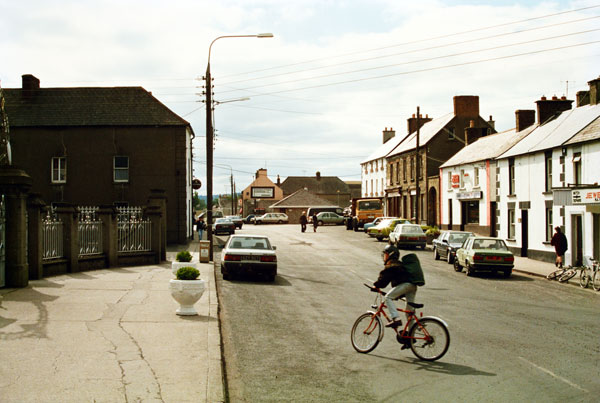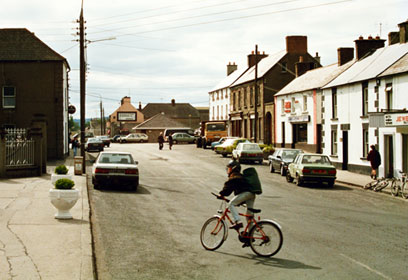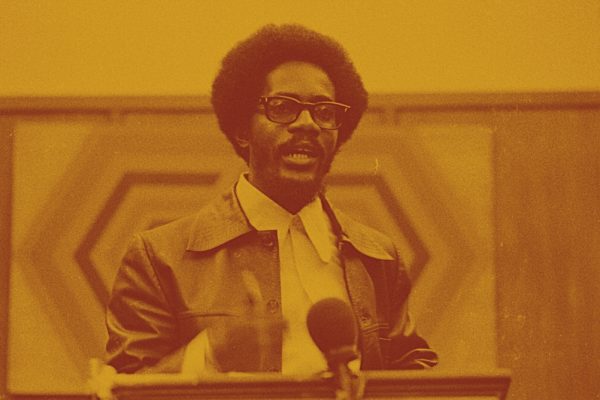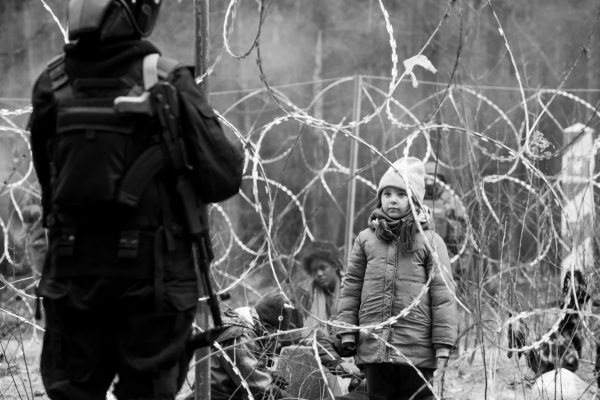
Bagenalstown, County Carlow, Ireland in 1991. Photograph: National Library of Ireland.
The end of the Cold War didn’t have obvious consequences for everyday life in Ireland. The great battle with communism seemed irrelevant to a country that had only gently been brushed by the forces of industrialized capitalism and affected a threadbare neutrality in international politics. Farming was the thing, even if it had gradually become an artificial creature reliant on European subsidies. The national radio station broadcast an agricultural news show, which mostly featured farmers complaining that they were not getting the grants to which they were morally entitled.
At the end of the Cold War, the Irish left was composed on the one hand of radicals slipping gradually into centrist respectability and on the other of sectarians maintaining their faith at the cost of public irrelevance. Some of the latter had difficulty adjusting to new circumstances. I used to own a poster issued by the Communist Party of Ireland (Marxist-Leninist) proclaiming, “In light of the collapse of traitorous revisionist regimes in Eastern Europe, all hail the success of genuine socialism in Albania.” I am not sure what they did after Albania, too, fell off the wagon in 1992. But then again, I am not sure what they did before that, either.
Ireland’s real Cold War was the episodic struggle over the power of the Catholic Church. After Irish independence, Catholicism had secured a stranglehold on the major institutions of social, political, and economic power. For many decades, the Church effectively controlled most of the schools (the main exception being a separate, smaller network run by the Protestant Church of Ireland) and hospitals, even though they were nominally provided by the state. It fought even the mildest social reforms for fear that change might dilute its influence.
Until the 1970s the Church also held a tight grip on key university departments such as philosophy and political science, to ensure that atheism and communism didn’t corrupt vulnerable youth. Trinity College—the traditionally Protestant university—was outside the Church’s grasp, but Catholics were discouraged, and in some cases forbidden, from attending. The national broadcasting station was closely monitored for smut and moral turpitude. When a guest on a popular talk show hinted that married couples might not always wear bedclothes, the statement provoked denunciations from a bishop and enormous political scandal.
Ireland’s real Cold War was the episodic struggle over the power of the Catholic Church.
But by the late 1970s, it was clear that the Church’s power couldn’t be sustained much longer. Religious conservatives turned from offensive to defensive tactics. They pushed through a referendum to introduce a ban on abortion in the constitution because they feared that without such a ban, legislation to legalize it would be introduced in a decade or two. They succeeded in defeating a referendum proposing a limited form of divorce. But the health minister (who later became a legendarily corrupt prime minister), Charles Haughey, responded to pressure to legalize contraception by introducing what he described as “an Irish solution to an Irish problem.” Contraception would only be legally available to people who could get a prescription from their doctor. This would allow married couples to regulate their fertility, while preventing unmarried couples from enjoying the delights of sin without the costs.
Such worldly compromises culminated in an extended period of confessional Brezhnevism. When my generation grew into adulthood in the 1980s, the culture of Catholicism seemed strong, if you didn’t look at it too closely. The vast majority of people attended church. I did too, although my sister and I would sit in a pew close to the front and ostentatiously walk out if we thought the sermon too conservative. But people’s hearts were not in it. Occasional conservative diehards aside, politicians defended Catholic values with the same empty enthusiasm with which they had embraced the moribund Irish language. Even the struggles against the Church seemed half ritualized. Some university’s students union would install a new condom vending machine for the benefit of its members. A few days later, in antiphon, the university authorities would rip the machine out in the middle of the night.
When it all changed, it changed quickly. In 1992 Eamon Casey, a prominent, media-friendly bishop, was discovered not only to have fathered a son, but to have maintained his son’s mother using church funds. The day the news broke, I met one of my professors, who had a sideline as a scrupulously evenhanded television host, wandering across campus in dazed delight. “It’s over,” he said. “They’ve lost.” He was right.
The people and their politicians no longer needed to pretend to believe. A second initiative to introduce divorce went to referendum and won narrowly, provoking accusations from a prominent No campaigner that her opponents were a bunch of “wife-swapping sodomites.” The Irish Parliament legalized homosexuality in 1993 against little opposition. Ireland, having long been a religious outlier in Western Europe, began to look like a modern secularized state, provided you were prepared to squint a bit.
As economic growth began to kick in, church attendance rates plummeted. Revelations that the Church had systematically covered up decades of sexual abuse curdled indifference into bitterness and anger. For a few years, it was a hard thing to be a priest in rural Ireland. It was rather better to be a criminal defense lawyer; for a while, religious orders were willing to spend generously to defend their disgraced brethren.
The changes brought about in the late ’80s and early ’90s only went so far. A self-congratulatory lay culture of unreflective Catholicism was easily transformed into a self-congratulatory culture of unreflective semi-liberalism. People today take a somewhat unseemly pride in their tolerance for sexual minorities, rather than simply taking their rights for granted. Currents of Catholic conservatism still flow beneath the surface of Irish politics and society, especially in hospitals and schools.
Ireland’s ban on abortion still stands, although it was modified to permit the procedure in cases where the life of the mother is at serious risk. In practice, though, it is still unavailable. In 2012 a woman whose child miscarried was refused an abortion because the fetus still had a heartbeat, and her life didn’t seem at imminent risk. She was reportedly told, “It was the law, that this is a Catholic country.” She died of massive septic shock. Even if the old regime lost its Cold War, its legacy endures.








